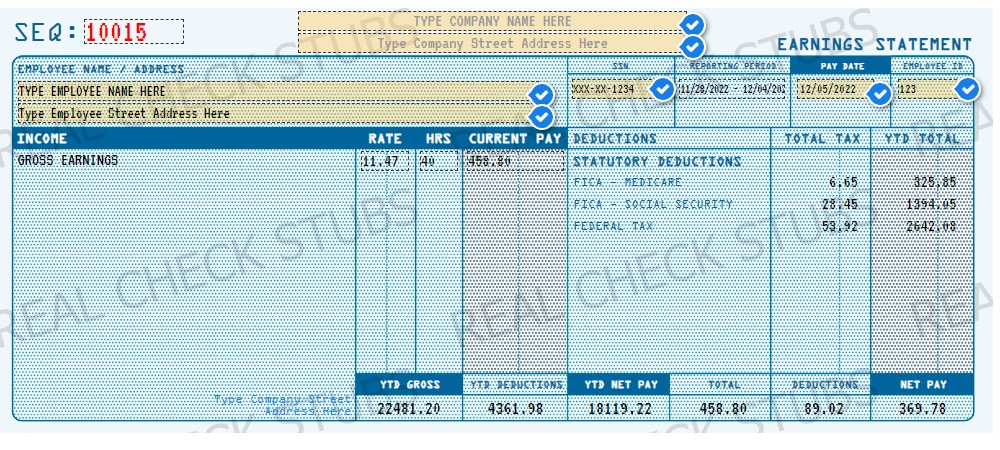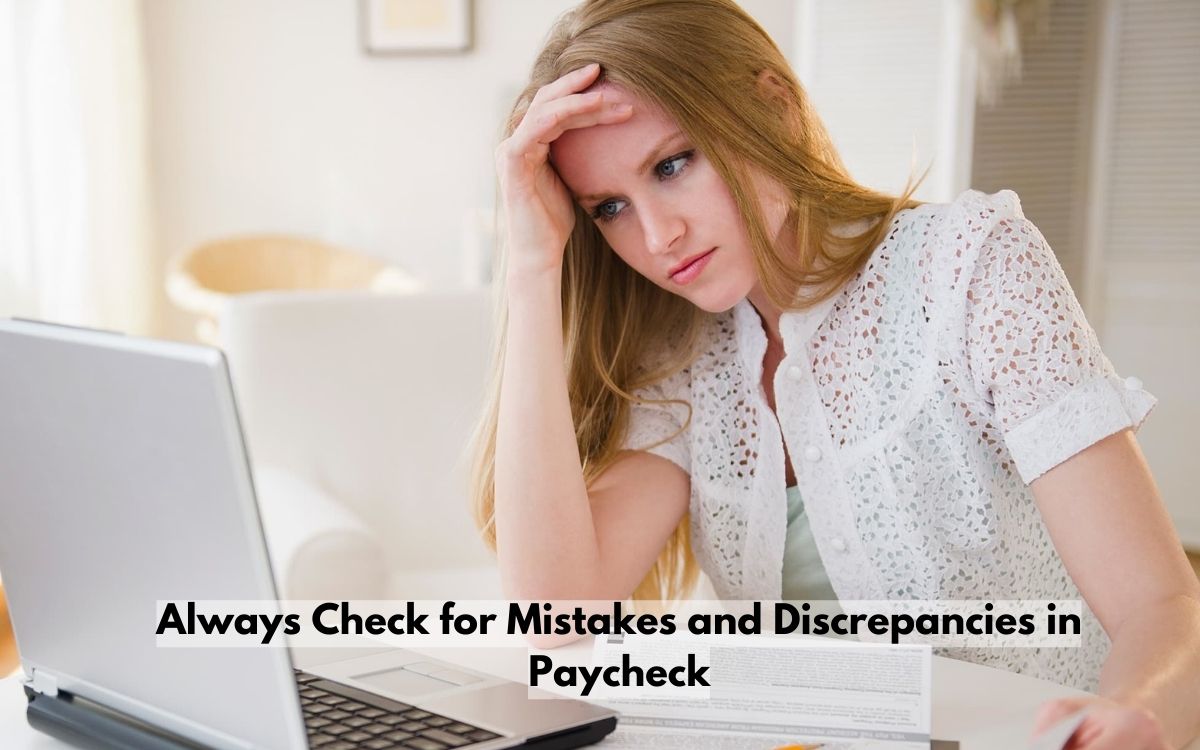Ensuring Check Stubs Are Accurate with Verification
Have you ever had a situation in which the amount of money being paid to an employee needs to be verified?
With check stubs, you have an easy way to confirm the accuracy of payroll amounts, ensure that all deductions are correctly accounted for, and provide your employees with proof of their income for tax purposes.
By vetting check stubs with verification, you can provide your employees with the confidence that their pay is accurate and secure.
Additionally, this process can help to protect your business from any potential legal issues related to payment records. With accurate and verifiable check stubs, you can ensure that all of your payroll documentation is in order.
Why Is It Important to Verify Check Stubs?
Verifying check stubs is essential because it prevents any discrepancies or doubts related to payments. If you suspect that an employee has not received the correct amount of pay, verifying their check stubs can quickly confirm whether this is the case.
In addition, ensuring your records are accurate and up-to-date helps avoid any potential payroll disputes or legal issues. Accurately verifying check stubs also ensures that your business is compliant with applicable labor laws and regulations.
Finally, taking the time to verify each employee’s check stub can help you save money by preventing any potential overpayments. Making sure payments are accurate and properly documented sets a good example for all employees and can help to ensure that the payroll process runs smoothly.
Verifying check stubs is a critical part of managing your business’s payroll and overall financial operations. Taking the time to regularly verify these documents helps protect both your employees and your business’s bottom line.
6 Things to Check on a Check Stub

Name and Account Number of the Payer
The first and most important thing to check on a check stub is the name and account number of the payer. This can be done by looking at the top portion of the check stub.
The ‘pay to the order of’ or ‘payee’ information on the stub includes the name of the payer, the account and routing number where the check was deposited, and the amount of the check.
This will help you verify the check stub and know if it is a genuine check or not. Similarly, the check number can be verified by looking at the bottom of the check stub. If the check number is there on your check stub, then it is definitely a valid check.
However, there are instances when the check number is missing—this is when the check stub is created before the check is issued. In such cases, the check stub will show ‘NSF’ or ‘not sufficient funds’.
This happens when the amount of the check exceeds the available balance in the payer’s account. This can be verified by looking at the check amount mentioned on the check stub.
Verification for Accuracy
Another important thing you can check on a check stub is the accuracy of deductions. When you receive a check, the payer may have deducted certain taxes, fees, or other charges from it. These charges are noted on the check stub and are deducted before the check is issued to you.
In such cases, you can verify the deductions by looking at your check stub. For example, if you receive a check for your services, the employer may deduct taxes from your check.
You can verify the amount of taxes deducted by looking at your check stub. If you find any errors or inconsistencies, you can contact the payer to rectify the situation.
Confirmation of Existing Checks and Balances
A check stub also shows you the details of the existing checks in your account. This can be verified by looking at the ‘items’ column on the check stub. It shows the check number, amount, date, and check/funds deposited. In case there is a difference between the check amount and the amount deposited, you can check for any error through the check stub.
This can be done by comparing the amount on the check stub with the amount mentioned on the actual check. If there is a discrepancy, you should contact your check-issuing bank and try to resolve the issue.
If there is a difference between the amount deposited and the check amount, then there may be an issue with the checks. The check-issuing bank may have returned the check due to a variety of reasons. You can confirm this by looking at the ‘returned checks’ column on the check stub.
Confirmation of Payer Information
The check stub is also a good way to check the payer information. In case you receive a check from a new or unidentified source, you can verify the payer information by looking at the check stub. Check the address and contact information of the payer on the check stub.
Alternatively, you can also call the contact number mentioned on the payer information to verify the details. If the details match, then there is no need to worry.
However, if there are a few discrepancies in the payer information on the check stub, then you should try to verify the information as soon as possible. This can protect you from potential scams or identity theft.
Confirmation of Deductions and Tax Adjustments
The last thing to check on a check stub is any deduction or tax adjustment. This can be done by looking at the ‘tax’ column on the check stub. The tax column shows any tax adjustments like taxes withheld from the check, state taxes, and federal taxes.
Check the tax amount on your check stub. If you find any inconsistencies in the amount, you can contact the payer to resolve the issue.
In some cases, the payer may adjust the amount of the check because of an error in the calculation of taxes. If you find any adjustment in the amount of the check, you should resolve the issue as soon as possible to avoid any complications.
Always Check for Mistakes and Discrepancies

After checking if taxes were withheld, you should look for any mistakes and discrepancies on the check stub. If there are any errors on the check stub, then you can contact your payer to get them corrected.
If you don’t bother to correct the mistakes on the check stub, they will be carried forward to the next transaction and may become a source of anxiety for you. You may come across any of these errors on your check stub:
- Wrong Date: The date that appears on your check stub must match the date on which the check was issued.
- Wrong Payer Name: The name of the person who issued the check must match what is written on the check stub.
- Wrong Account Number: The account number that appears on the check stub must match the payer’s account number.
- Wrong Check Number: The check number that appears on the check stub must match the number of the check you have received.
- Incorrect Amount: The amount that appears on the check stub must match the amount you have received in the check.
By verifying all the details, you can ensure that your check stub is accurate and free of mistakes. So always be sure to do a thorough review and verification process before signing off on any check stub. With proper verification, you can rest assured that your payments are accurate and secure.
FAQs
Can employers verify pay stubs?
Yes, employers can verify pay stubs. Employers can use check stubs with verification to confirm the accuracy of employee payments. The employment verification process can help ensure employees are receiving their correct wages and help employers remain compliant with state and federal laws.
Additionally, verifying an employee’s pay stubs can be beneficial for payroll audits and other compliance reviews.
Can you fake pay stubs for employment verification?
No, it is not recommended to fake pay stubs for employment verification. Accurately verifying payroll information is essential to the success of a business and can help mitigate any potential issues that may arise in the future.
Employers should always use reliable and verified methods for confirming employee payment information. Falsifying or misrepresenting employment records could lead to penalties or legal action from the government.
What happens if you use fake pay stubs?
Using fake pay stubs can lead to serious consequences, including possible criminal penalties. It is important for employers to understand the importance of accurate employee records and use secure methods for verifying payroll information.
What to black out on pay stub for apartment applications?
When providing pay stubs for an apartment application, it is best to black out or redact any sensitive information that is not necessary.
This can include Social Security numbers, bank account information, and even full addresses. Only provide the requested payroll records with the essential details needed to complete the application.
Only Use Real Check Stubs
When you sign up for Real Check Stubs, you’re guaranteed to receive accurate, up-to-date payroll records with the information needed to complete your employment verification. Our secure platform ensures all of your private data is kept safe and secure while providing you with the verified documents you need. Don’t risk using fake pay stubs—sign up for Real Check Stubs today!
Kristen Larson is a payroll specialist with over 10 years of experience in the field. She received her Bachelor's degree in Business Administration from the University of Minnesota. Kristen has dedicated her career to helping organizations effectively manage their payroll processes with Real Check Stubs.

